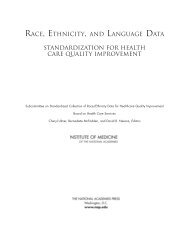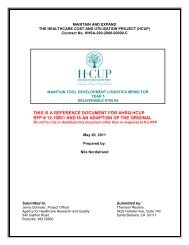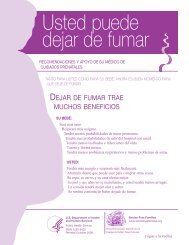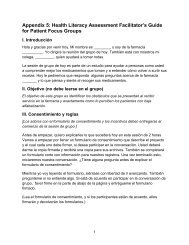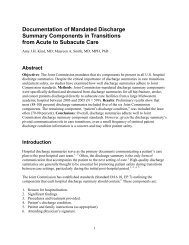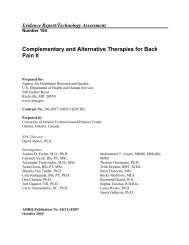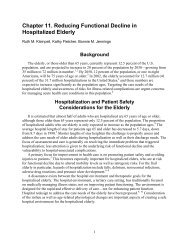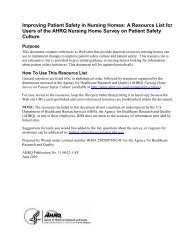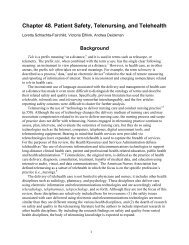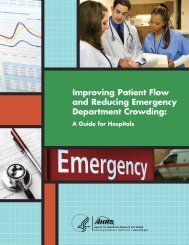Chapter 46. Magnet Environments for Professional Nursing Practice
Chapter 46. Magnet Environments for Professional Nursing Practice
Chapter 46. Magnet Environments for Professional Nursing Practice
You also want an ePaper? Increase the reach of your titles
YUMPU automatically turns print PDFs into web optimized ePapers that Google loves.
Patient Safety and Quality: An Evidence-Based Handbook <strong>for</strong> Nurses<br />
hospitals. The four researchers on the task <strong>for</strong>ce were working from the knowledge that despite a<br />
nursing shortage <strong>for</strong> a large number of hospitals, a certain number “had succeeded in creating<br />
nursing practice organizations that serve as ‘magnets’ <strong>for</strong> professional nurses; that is, they are<br />
able to attract and retain a staff of well-qualified nurses and are there<strong>for</strong>e consistently able to<br />
provide quality care” 8 (p. 2). There<strong>for</strong>e, the research goal was set to explore the factors<br />
associated with success in attracting and retaining professional nurses.<br />
Through an extensive nominating process, 41 hospitals from across the country were selected<br />
to participate in the study based upon their known reputations as being good places <strong>for</strong> nurses to<br />
work and the evidence they submitted to document a relatively low nurse turnover rate. 9<br />
Subsequently, a series of group interviews was held with representatives from each hospital.<br />
Two interviews were conducted in each of eight geographically dispersed locations. In the<br />
morning, one of the task <strong>for</strong>ce researchers interviewed the chief nurse executives from the<br />
participating hospitals in that area. Then, in the afternoon, a second group interview session was<br />
held with staff nurses. Each staff nurse who participated in the interviews was selected by his or<br />
her chief nurse executive.<br />
Based upon their analysis of this interview data, the task <strong>for</strong>ce researchers identified and<br />
defined a set of characteristics that seemed to account <strong>for</strong> the success the 41 reputational magnet<br />
hospitals had enjoyed in attracting and keeping a staff of well-qualified nurses at a time when<br />
other hospitals around them were not able to do so. The labels given to these characteristics,<br />
which have come to be known as the <strong>for</strong>ces of magnetism, are listed below in Table 1. Many of<br />
the insights they embody have a long history of study within the sociological literature related to<br />
organizational per<strong>for</strong>mance, leadership, worker autonomy and motivation, decentralized or<br />
participative management, work design, coordination and communication, effective groups and<br />
teams, and organizational innovation and change. 10<br />
Table 1. The <strong>Magnet</strong> Characteristics of a <strong>Professional</strong> <strong>Practice</strong> Environment<br />
Forces of <strong>Magnet</strong>ism 1983 (McClure) 8 Forces of <strong>Magnet</strong>ism 2005 (ANCC) 11<br />
Administration<br />
Quality of leadership<br />
Organizational structure<br />
Management style<br />
Staffing<br />
Personnel policies and programs<br />
<strong>Professional</strong> practice<br />
<strong>Professional</strong> practice models<br />
Quality of care<br />
Quality assurance<br />
Consultation and resources<br />
Autonomy<br />
Community and the hospital<br />
Nurses as teachers<br />
Image of nursing<br />
Nurse-physician relationships<br />
<strong>Professional</strong> development<br />
Orientation<br />
In-service and continuing education<br />
Formal education<br />
Career development<br />
1. Quality of nursing leadership<br />
2. Organizational structure<br />
3. Management style<br />
4. Personnel policies and programs<br />
[staffing embedded in #4]<br />
5. <strong>Professional</strong> models of care<br />
6. Quality of care<br />
7. Quality improvement<br />
8. Consultation and resources<br />
9. Autonomy<br />
10. Community and the hospital<br />
11. Nurses as teachers<br />
12. Image of nursing<br />
13. Interdisciplinary relationships<br />
14. <strong>Professional</strong> development [original<br />
subgroups embedded]<br />
Note: Order shown in the left column has been slightly rearranged <strong>for</strong> ease of comparison.<br />
2



